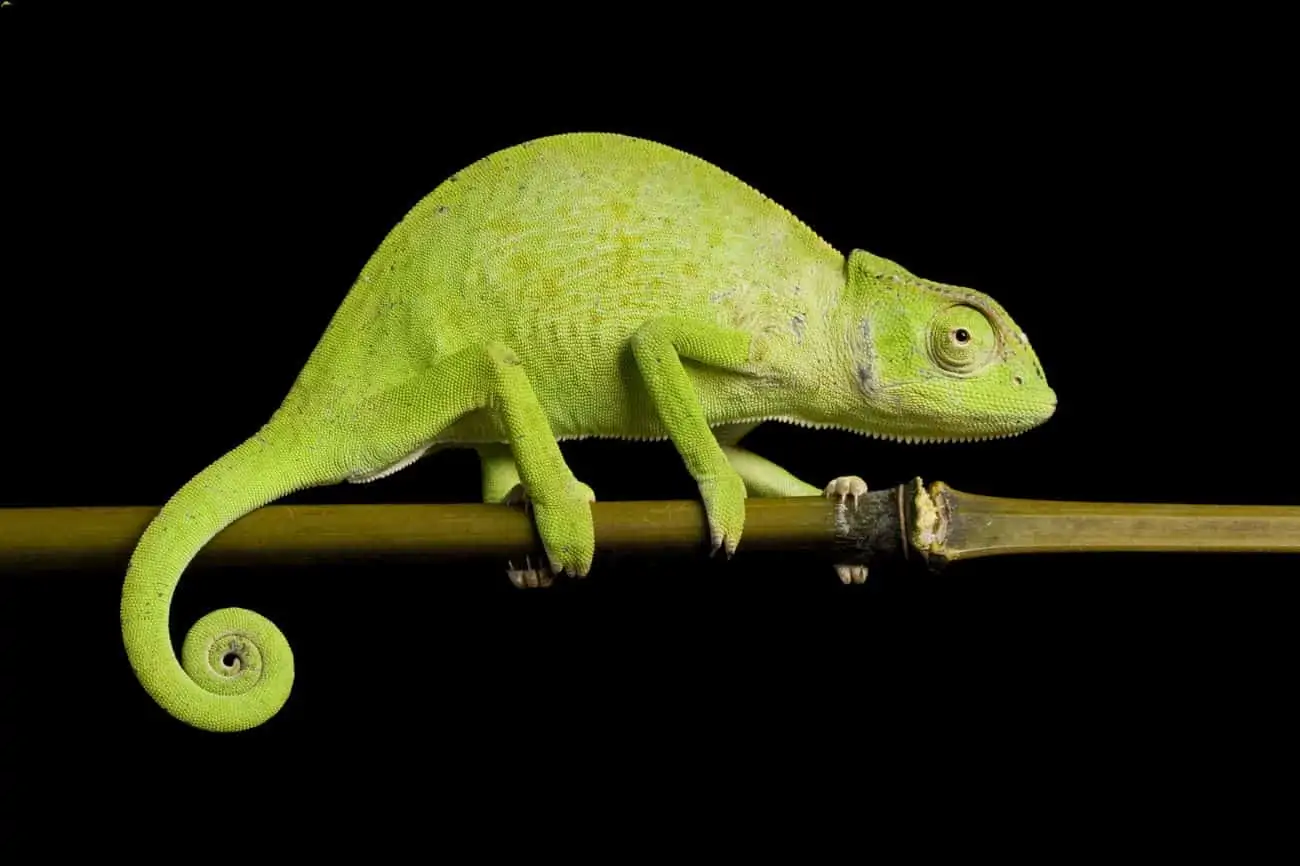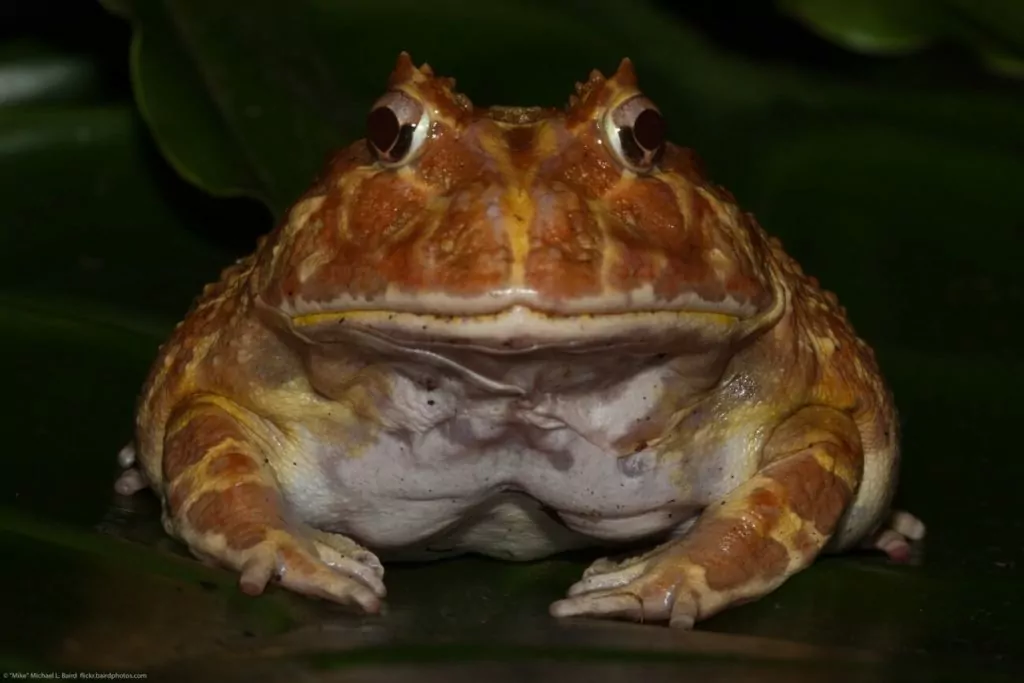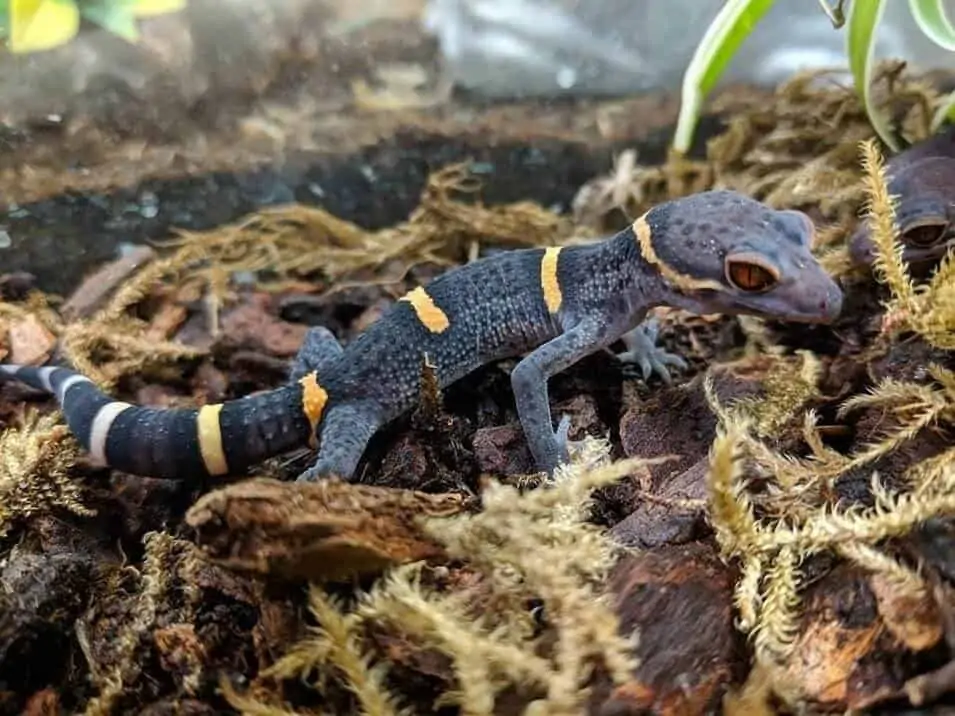Senegal chameleons are lovely pet reptiles that have a lot of character. Not only do they look great, but they also have a sweet and shy temperament that we absolutely love!
But there are some things you’ll need to be aware of before you consider owning one as a pet. These chameleons are quite sensitive, so they need perfect care!
Don’t worry, this guide will make things easy. In it, you’ll learn everything you need to know about Senegal chameleon care.
Let’s get started.
Table of Contents
Species Summary
The Senegal chameleon (Chamaeleo senegalensis) can be found in the savannahs of African countries such as Senegal, Benin, Togo, Mali and Liberia.
Most of the Senegal chameleons found in pet stores are wild-caught, so you’ll need to be very careful before bringing one home. Wild-caught adults are usually full of parasites, and they often don’t live as long as juveniles or captive hatched chameleons.
Expert Tip: Regardless, always bring your new chameleon to the vet for a thorough check up and fecal test. Most importantly, make sure that you purchase your chameleon from a trusted and reputable dealer!
Senegal chameleons are sweet, shy creatures that tend to do well in a very carefully monitored environment. These types of chameleons are also quite delicate and prone to stress-related issues. Only people with advanced reptile experience should attempt to own one of these chameleons.
Appearance & Colors
The Senegal chameleon does not have the flashy colors that some reptile enthusiasts look for. But if you love chameleons and have an observant eye, you will appreciate the subtle color variations that these adorable chameleons will display while they go about their daily business.
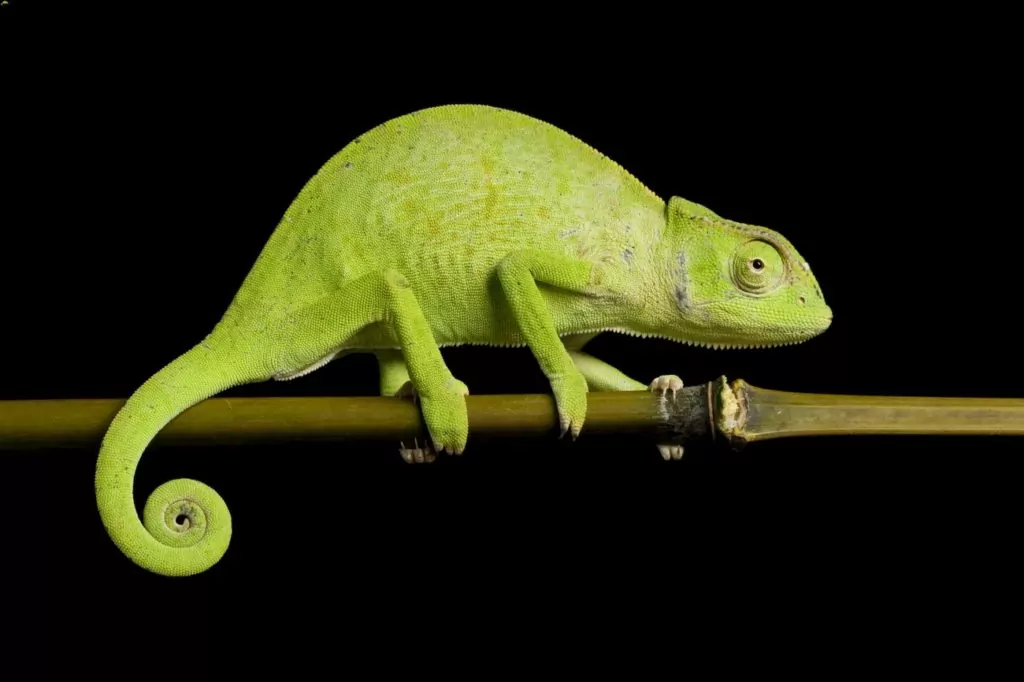
The base color of the Senegal chameleon is a rather plain, light brown, but depending on the mood and situation, this chameleon will display subtle color changes.
For example, if your Senegal chameleon is just resting and chilling out, it will appear green with blackish spots. When it’s basking, it will look light brown with darker brown spots and patterns. Mating, roosting, hunting and other activities will bring about more color changes.
A long, curled tail, zygodactylous feet (two toes facing forward and two toes facing backward), a cubed head and bulging eyes, give the Senegal chameleon fairly typical chameleon features. However, a tiny neck flap sets them apart from other chameleon species.
Average Senegal Chameleon Size
The average Senegal chameleon size is between six and eight inches long. This length measurement includes their rather long tail.
Expert Tip: Female Senegal chameleons tend to be a bit longer than males. However, the difference isn’t vast.
Lifespan
The lifespan of a Senegal chameleon is around five years in captivity. This is assuming great care and a nutritious diet is provided.
These are delicate reptiles, so their lifespan will suffer significantly if their basic needs aren’t met.
Senegal Chameleon Care
Senegal chameleon care is definitely manageable for anyone with an advanced knowledge of reptile husbandry. Despite their fragile and shy nature, these reptiles can make rewarding and lovely pets.
The enclosure that you create will need a heat gradient, specialized lighting, plenty of enclosure enhancements and a consistent source of water.
You’ll also need to possess an understanding of Senegal chameleon behavior. This is especially important if you plan to own more than one chameleon.
Enclosure Size
Before you even think about creating an amazing habitat for your chameleon, you’ll need to figure out what kind of physical structure you’re going to use. Here are a few helpful points to consider:
- Your Senegal chameleon loves to climb and explore, so it’s a good idea to create an enclosure that’s taller than it is wide.
- These chameleons are prone to respiratory infections that come from a lack of air circulation. Using a screened enclosure is highly recommended and will help you avoid this problem.
- For one chameleon, we suggest using an enclosure that’s 18 inches x 18 inches x 24 inches. If you have room, using a larger enclosure is even better.
Expert Tip: Housing adults together is not recommended. They are very territorial and may even become quite aggressive with each other. Juveniles can be housed together with some success.
Habitat Setup
Creating the perfect habitat setup for your Senegal chameleon can be very rewarding. Once you understand some of their basic needs, you can make a space that’s inviting and comfortable for your new pet. Don’t forget that the enclosure you design can be a beautiful and treasured addition to your own living space as well!.
Your enclosure is not going to require a specialized substrate. Many Senegal chameleon owners simply use newspaper or a reptile carpet.
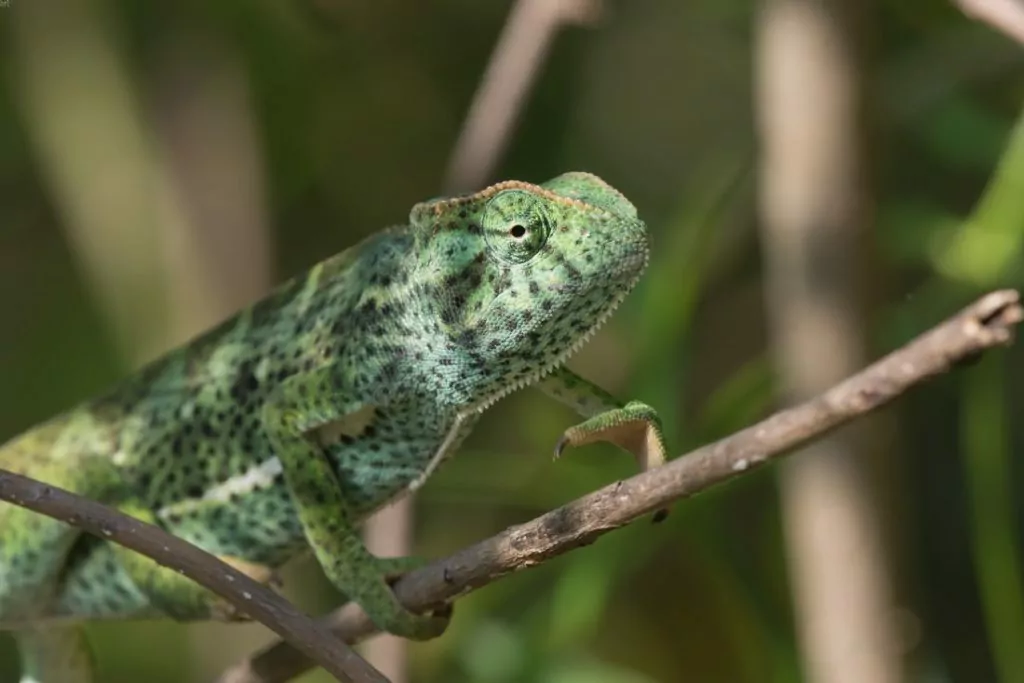
Probably the most important items in your enclosure are going to be the plants that you choose.
Senegal chameleons love to climb, and they need plenty of places where they can hide and feel safe. In fact, the taller the plants, the better because these chameleons feel the safest in high places.
Expert Tip: Before choosing plants to place in the enclosure, make sure that they are non-toxic and free of pesticides. Another point to consider before you begin plant shopping is that Senegal chameleons can get stressed out by bright colors. They may not appreciate having a plant that has red or orange flowers.
We suggest using a combination of live and artificial plants. If you have a nice tall enclosure, you can keep the plants in pots. There is no need to plant them in any kind of special substrate.
Plants that are safe and appropriate include golden pothos, hibiscus and ficus. Pick plants that grow tall and have plenty of foliage to create hiding spots.
Temperature & Lighting
Getting the temperature and lighting of the enclosure right is extremely important. First of all, you’ll have to decide on how you’ll set up the temperature gradient. This means that there has to be a warmer area for basking and a cooler section for bringing down the body temperature.
To create this gradient, we recommend having a warmer basking area on one side of the enclosure and a cooler spot on the other side. Your chameleon will alternate between these two sides in order to regulate its body temperature.
Here are the temperature ranges to remember:
- The temperature in the basking area should always remain between 85°F and 90°F
- The rest of the enclosure should be around 74°F to 80°F
- A nighttime temperature of 72°F is perfectly acceptable
To maintain the proper basking temperature, you can use a reptile basking light. However, many chameleon owners use a 60 watt bulb, and it works just fine. Installing a thermometer in the enclosure will let you know if the bulbs are doing their job. Never put the bulb inside the enclosure, since it can get too hot and burn your pet.
In the wild, the Senegal chameleon gets plenty of UVB light. This helps with metabolism, growth and the production of Vitamin D3. It is also necessary for bone and joint health. Adding a UVB fluorescent bulb to your enclosure is definitely recommended.
For the general lighting schedule, we suggest using a 12 hours on, 12 hours off routine.
Humidity
One of the most important parts of Senegal chameleon care is meeting their need for a high level of humidity. Maintaining a humidity level of 60-90 percent is critical.
To keep the enclosure at the proper level of humidity, you can use a manual spray bottle to thoroughly mist the enclosure several times a day. Some chameleon owners use an automatic drip system that supplies a constant source of water and helps with humidity. Either method works well.
Use a hygrometer to make sure that the method you choose is keeping the enclosure humid enough. Invest in a reliable one to make sure you’re getting accurate readings!
Expert Tip: Having plenty of foliage in the environment also helps to maintain humidity levels.
Water
The Senegal chameleon is a big water drinker. To satisfy its almost insatiable need to drink, you are going to have to figure out how to supply a consistent water supply.
These chameleons don’t drink from water bowls. Instead, they prefer to lick water droplets from foliage or other enclosure enhancements.
Using the drip system mentioned in the humidity section above, you can provide a non-stop supply of water. They will also get water when you mist the enclosure, but the drip system ensures a more consistent source of droplets.
If you opt for the drip system, make sure to have a drainage system that will catch excess water. This will prevent the enclosure from getting too wet.
Food & Diet
Senegal chameleons have huge appetites and love live prey like crickets, mealworms and dubia roaches. To add extra nutrition to their food, it’s really important to gut load the prey before you give it to your chameleon. Dusting the prey with calcium and vitamin powder is another critical step.
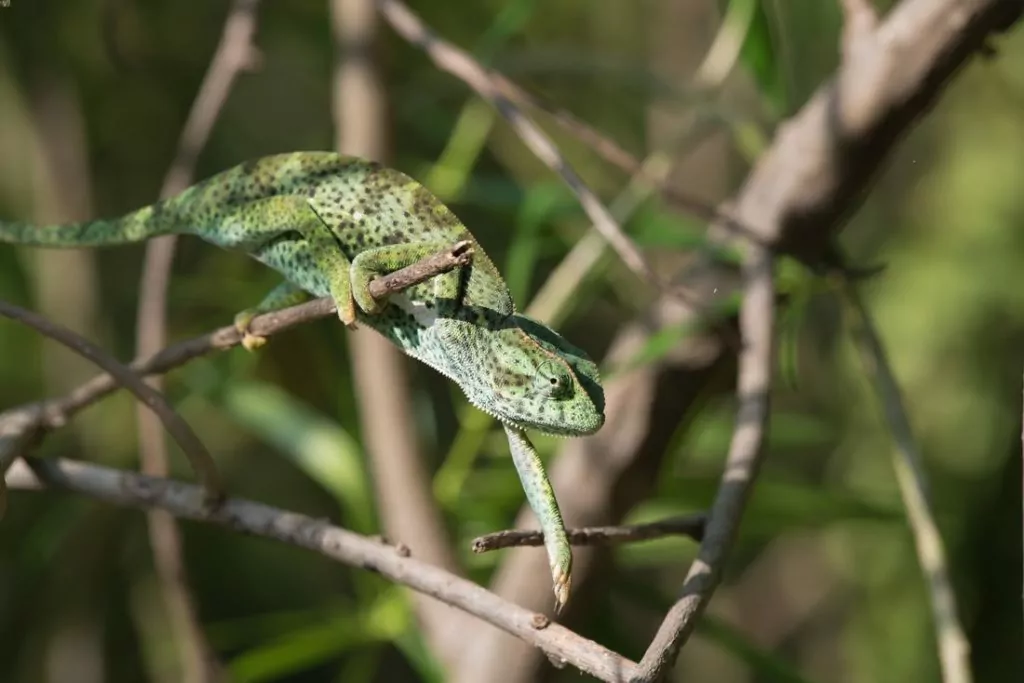
As far as a feeding schedule goes, adults can eat five to ten large crickets every other day. Juveniles and small Senegal chameleons can be fed every day.
Expert Tip: Be very careful not to give your chameleon more food than it will consume in one feeding session. If you leave uneaten prey in the enclosure, it may bite your chameleon.
Possible Health Concerns
Because the Senegal chameleon is fairly delicate, it is susceptible to a myriad of health problems. Some health issues to watch out for include:
Intestinal parasites: These are an issue that can be a real problem for Senegal chameleons. It is very important to get routine fecal tests done in order to deal with infestations before they get out of control. Wild-caught adults are particularly prone to these parasites.
MBD: Metabolic bone disease is another potential health problem that is common to Senegal chameleons and reptiles in general. It’s caused by a lack of UVB lighting, and a painful bone condition can be a result. Using a UVB bulb in the enclosure can help to prevent this disease.
Mouth rot: This is definitely something to look out for because it can develop into a bad infection very quickly. Signs of mouth rot include drooling and redness around the mouth.
Respiratory infections: These can be the result of low temperatures in the enclosure. They can also come from poor diet or dirty enclosure conditions. Signs of a respiratory illness include lethargy, lack of an appetite or nasal discharge.
Nutritional deficiencies: Vitamin A and calcium deficiencies are another health issue to watch out for. A good diet and UVB light supplementation can help to prevent these deficiencies.
Stress: This might surprise you, but stress can wreak havoc with your chameleons immune system. Over handling or being housed with other chameleons can cause extreme stress.
If you notice lethargic behavior, any type of discharge, redness, skin issues or a lack of appetite, take your Senegal chameleon to your trusted reptile veterinarian right away. It’s always good to take your pet for regular wellness check ups too.
Behavior & Temperament
Senegal chameleons are shy and delicate. Because of this they don’t really like to be handled (more on that in the section below).
Instead, they prefer to climb and explore their surroundings. In fact, the more foliage and high places to climb within the enclosure, the better. They feel very safe and happy when there is as much foliage as possible in their environment.
Adult Senegal chameleons do not like to be kept together. It makes them very nervous, and males will often engage in violent fighting.
Interestingly enough, juveniles can be housed together and often display a unique behavior. When placed together, juveniles will sit in a row holding tails! They will only do this with other chameleons that they know and trust.
Handling Them
If you’re looking for a pet reptile that likes to be handled, the Senegal chameleon is probably not for you. They really dislike handling and will typically become very stressed when you attempt it.
With time and patience, some owners can train their chameleon to tolerate handling, but this is not really recommended.
The Senegal chameleon is an interesting and amazing reptile that is best left to hide, climb and bask in peace!
Conclusion
Senegal chameleon care is something we recommend for owners with a bit of experience. Because of the sensitive nature of these reptiles, there isn’t a lot of room for error!
But if you’re comfortable with the task and are prepared to give these little creatures what they need, you’ll find ownership to be quite rewarding.
Contact us if you think there’s anything else we should add to this care sheet. We do our best to include as much actionable info as possible, but we’re always open to suggestions!

